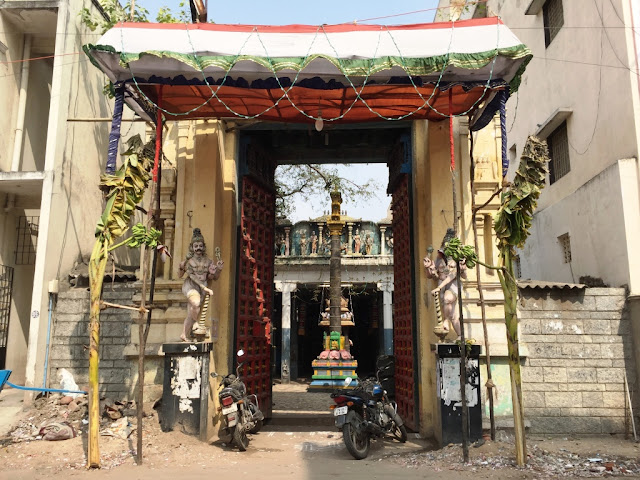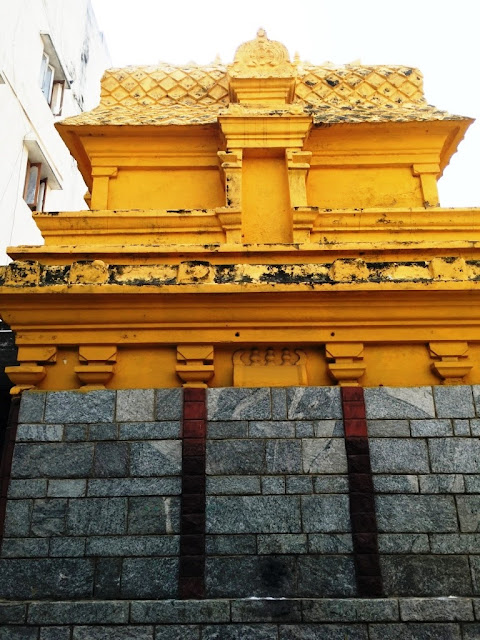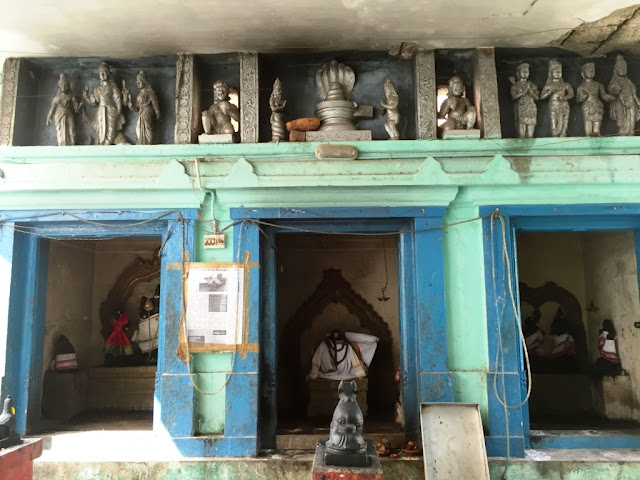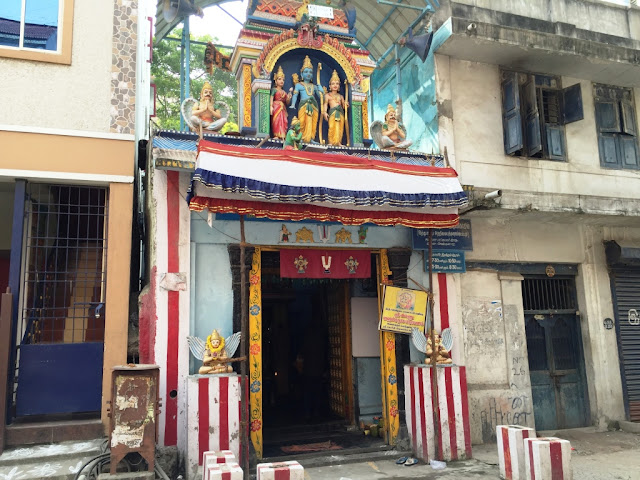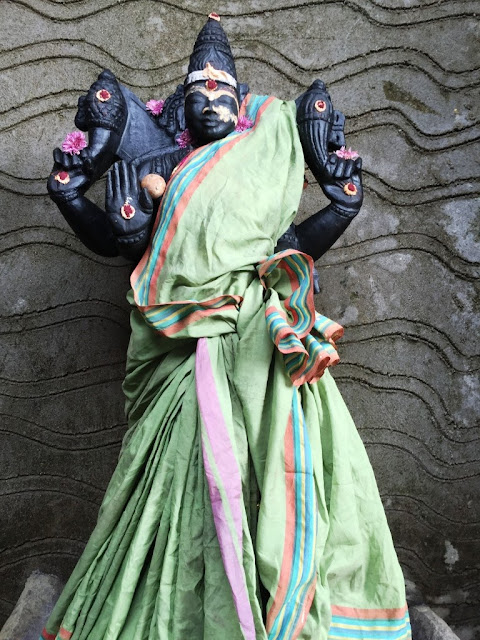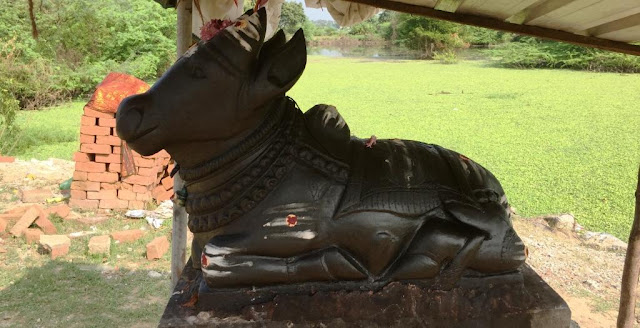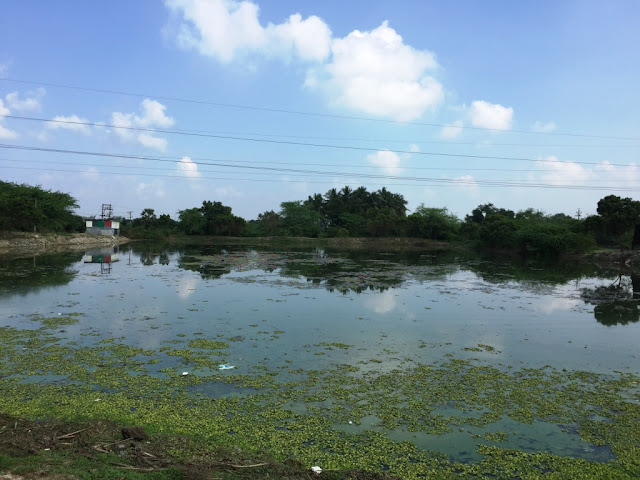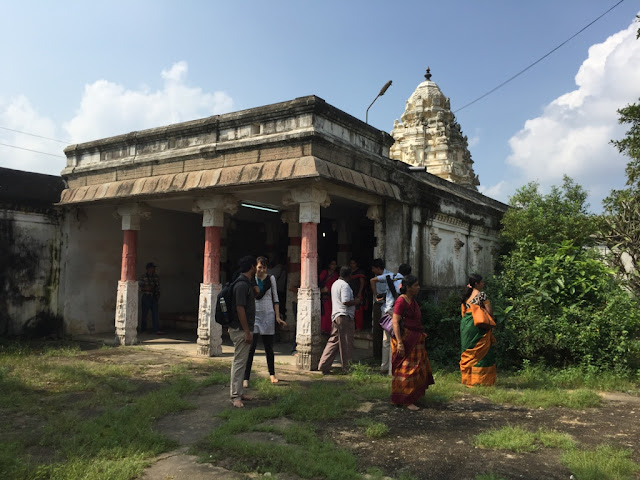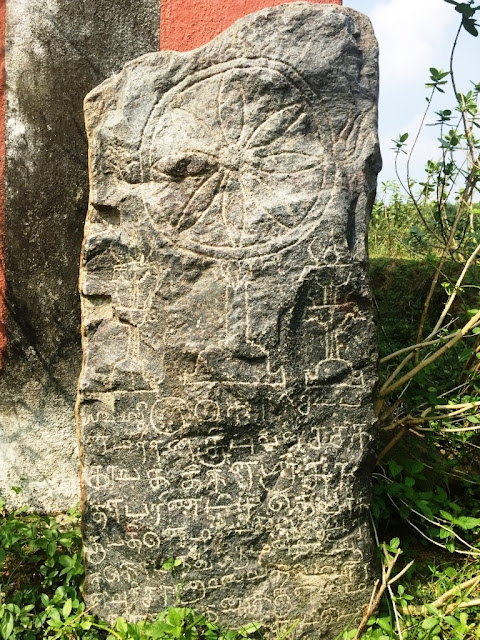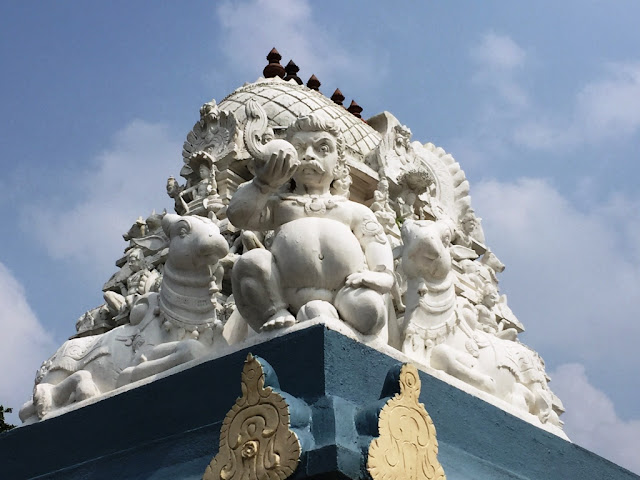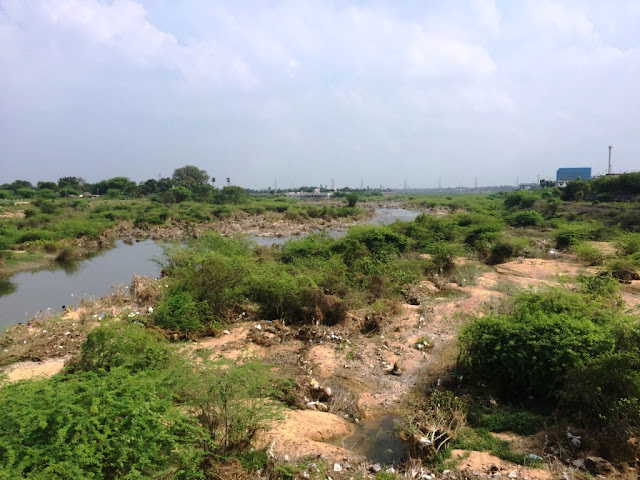21st,
December 2015.
It
was a pleasant journey to the temples Thiruverkadu, Voyalanallur,
Sitharkadu, Aranvoyal, Tirur, and the Korattur barrage which diverts the Koovam
water to Chembarambakkam on the banks of the holy river Koovam with a like-minded people who believes in history on the Saturday 19th December
2015. The tour was originally planned for December 6th, 2015,
but the same was postponed for want of access through the road after the rain
and flood in the river Koovam. The flooded river Koovam had
done extensive damage to the buildings constructed on the banks
and the roads that connect to the Villages.
We,
about 24 persons in two vans, started our journey from opposite TTD
Perumal Temple (had the Darshan of Sri Balaji but missed the Pongal since we
were a little late) after loading the breakfast and the lunch.
The usual road to Thiruverkadu was closed to traffic and we had to detour in
many places and finally reached Sri Vedapureeswarar Temple at Thiruverkadu.
SRI VEDAPUREESWARAR TEMPLE, THIRUVERKADU
This
is my third visit to this temple. My previous visits are made in connection
with the Devaram Paadal Petra Shiva Sthalangal ( for details CLICK HERE ). Every time I visit these temples I used to learn new
things. The temple was constructed by Sri Rajendra Chozha’s second son
Kulothunga from 1050 to 1063 AD. The temple also has the
contributions of Telugu Chozha and Nayak rulers. This place was
also called Mummudi Chozha Nallur. The sanctum is of Gajabirustam
type. There are about 11 inscriptions that are not legible to read due to improper maintenance on walls. The special feature in this temple is Sri
Subramaniar sannadhi in the inner praharam without his usual weapons,
vahana, and concerts. The Sivalingam installed and worshiped by Lord
Muruga is in his front. There are two Chandikeswaras of which one is
without mandapam. Lord Shiva gave kalyana Kola darshan to sage Agathiyar,
who could not attend the wedding at Kailash. Lord Shiva and Parvati’s
images are on the back of the moolavar in a sitting posture.

The 5 tier Rajagopuram
The meta-colour sheet mandapam
obstructs the front view of the temple
The meta-colour sheet mandapam
obstructs the front view of the temple
Ambal sannidhi entrance arch on
the south
Gajabirusta Vimanam
Padmapriya explains the details of the temple
Vimanam (
Mr. Venkatesh saying Rava kesari is very good )
Our next stop was at Voyalanallur and had the darshan of Sri
Kandha Swamy and Sakthimutreeswarar. On the way, we intimated the
Gurukkal Sri Hari ( mobile 9003154640), who does poojas in many temples.
SRI KANDASWAMY TEMPLE, VOYALANALLUR
Sri Kandaswamy’s (Brahma Sastha) Murti is more than 6 ½
feet, an original Aditya Chozha’s period under a recently constructed house-like shrine. The moortham is in excellent condition and very cute
with a simple alangaram. The Arathi by Gurukkal enhanced the beauty of Sri
Kandaswamy. There is an inscription pillar about 3 feet high
standing in front of the shrine. There are two stone slab inscriptions belonging to
Sri Sakthimutreeswarar temple also lie in front of the temple. These inscriptions belong to 895 AD, of Adithya – I recorded
during 1952-53.
Sri Kandaswamy –
Brahma Sastha, a life-size image without alangaram/decoration looks very cute
Sri Kandaswamy –
Brahma Sastha a life-size image with simple alangaram looks very cute
The inscription pillar in front of Sannathi
The inscription stone
slab belongs to Sri Sakthimutreeswarar temple
SRI
SAKTHIMUTREESWARAR TEMPLE, VOYALANALLUR
From
Sri Kandaswamy temple we walked on the banks of Lotus tank to
Sakthimutreeswarar temple. Moolavar Sri Sakthimutreeswarar is a little big
in size and belongs to Aditya Chozha’s period and Ambal and Rishabam from the latter period. The temple structure is of recent one, facing east. The
inscriptions are available at Sri Kandaswamy temple.
TEMPLE TIMINGS
:
Since
there is no fixed time, Gurukkal Hari may be contacted through his mobile
9003154640 for darshan
HOW
TO REACH :
The
place Voyalanallur is about 2 Km from Kolappancheri.
Town
bus 54c from Poonamallee passes through this village.
Temple lotus pond

We continued our journey to Sitharkadu to get the blessings of Sri
Sundararaja Perumal and Sri Dhatreeswarar. This is my second trip to
this Village. (For details of my first visit please CLICK
HERE) During my first visit after learning from
Alayam Kanden’s blog by Padmapriya, ( Since My son’s birth star is also Swathi, and this made me visit this temple ) I could not visit Sri
Sundararaja Perumal temple. We had our first darshan of Sri Sundaraja Perumal since the Batter was waiting for us.
SRI SUNDARARAJA PERUMAL
TEMPLE, SITHARKADU ( THIRUMANAM
VILLAGE )
Front view with Vilakkuthoon, balipeedam, Dwajasthambam, and Garudalvar sannadhi
Moolavar : Sri Sundaraja Perumal
Thayar
: Sri Sundaravalli
The temple faces east with a 5 tier Rajagopuram. In the outer
praharam sannadhi for Thayar Sri Sundaravallai and Sri Andal both
are facing east. In the main shrine, Moolavar Sri Sundaraja Perumal is with
Sridevi and Bhoodevi. In the front mandapam moorthams of Senaimudalvar,
Namalwar, Thirumangai alwar and Thirumizhisai alwar. Garudakodi Siddhar’s relief
is, one of Sri Andal Sannidhi’s pillars. By worshiping this sithar
one can get rid of eye-related ailments. There are 17 reliefs for Narasimha Perumal who was born on Swathi Nakshatra day, available on the pillars of
this temple.
The temple was constructed during Sundara Pandiyan’s period and is presently managed by the Thuluva Velala Sri Nallathambi’s descendants through the
income from 100 acres of land. Searched for any inscription and
finally, we were able to locate the inscription tablet on the southeast corner of
the outside compound wall.

The mandapam on the
north side of the entrance
Moolavar Vimanam
Sundaravalli Thayar sannidhi
Andal sannadhi
Front view with
Dwajasthambam, Garudalvar sannadhi
Thirumazhisai Alwar
Garudakodi Siddhar
Sri Krishna Leela relief on the pillar of the
mandapam
The Temple viruksham amla
tree with Thulasi
The inscription was installed outside ( southeast corner of the compound wall )
DHATREESWARAR TEMPLE ( SRI NELLEESWARAR), Sitharkadu
Main sannadhi view with Dwajasthambam, balipeedam and Rishaba mandapam
Moolavar : Sri Dhatreeswarar
Consort : Sri Prasunakundalambigai
During my first visit to this temple, the renovation was in full swing and the temple was under palalayam and could not
get the inside details. ( for the details of my earlier visit CLICK
HERE). After kumbhabhishekam the temple looks cute.
Ambal
was found in Nandhavanam and is called Poongkuzhali.
HISTORY AND INSCRIPTIONS
There
is an interesting detail that Devadasis donated land to this temple.
The temple was built during Sundaravarman’s period with Nayak’s period thirupani at a later stage.
LEGENDS
The temple is a Swathi star temple and also a Marriage parihara sthalam.
It was believed that three siddhars worshiped Lord Shiva under the Amla ( Nelli ) tree. They are Prana Theerthika Siddhar ( for breathing/lungs related ailments ), Jadamudi Siddhar (Heart-related ailments), and Garudakodi Siddhar (eye-related ailments – whose relief is at Andal sannadhi of Sundaraja Perumal Temple pillar ).
POOJAS AND CELEBRATIONS
Some of the important festivals are, On Thiruvathirai Shiva & Parvati marriage will be celebrated. The celebration of Parivettai is a special attraction, in that Ambal and Swamy will run toward each other from opposite directions.
TEMPLE TIMINGS
The temple is kept open between 08.00 Hrs to 10.00 Hrs and 17.30 Hrs to 19.30 Hrs
CONTACT
DETAILS :
Kumar
Gurukkal may be contacted through his mobile 9444793942 for further details.
HOW TO REACH :
Town
bus route No M153 from CMBT to Pattabiram and M45C from Poonamallee to
Pattabiram passes through this village.
Also
from Pattabiram railway station, it is about 4 KM, Share autos are available up
to the bridge, and from there can be reached through a small walk.
Artistically carved
panel on the ceiling of Rajagopuram
Front arch after Rajagopuram
Main sannadhi view
with Dwajasthambam, balipeedam and Rishaba mandapam
Moolavar sannadhi
Artistically carved panel on the ceiling of Moolavar Sannadhi
Dakshinamurthy
Sri Valli Devasena Subramaniar
Natarajar with
Sivakami and Manickavasagar
Utsavars
Pranatheertha Siddhar - To worship for breathing-related ailments
A Vinayagar sannidhi
in front of the Main Temple
Our next destinations are Aranvoyal and Tirur off the
main road from Poonamallee to Thiruvallur Road. These two Villages are
opposite to each other little away from the River Koovam. Visited both temples during our heritage tour with the R.E.A.C.H foundation (
for details please CLICK
HERE ).
THIRUTHALEESWHARAR TEMPLE. ARANVOYAL
Moolavar :
Thiruthaleeshwarar
Consort :
Sri Maragathambigai
During our earlier visit to this temple, renovations were in
progress and this time lot of improvements were done and Rajagopuram
construction is in progress. It was sad to see the old pillars of Rishaba mandapam dumped in one place with Aditya Chozha Period inscriptions.
Pallava period thirupani can also be seen.
Vinayagar at the
entrance of the main shrine – why does he use a snake as a belt?
The south side
entrance arch to the main shrine
The east side view
with Dwajasthambam, balipeedam, and Rishaba mandapam ( Rishabam is waiting to be installed)
Boothagana with Rishabam and moolavar Gajabirushta Vimanam
Rishabam mandapam ( Rishabam is waiting to install )
Wooden Rishabam used
for urchavam- வாலாட்டும் இடபம்
Adhitya Chozha Period
inscription on the pillar
Adhitya Chozha Period
inscription- pillars of old Rishaba Mandapam - removed and kept outside
SRI SRINGANDEESWARAR TEMPLE, THIRUVUR ( TIRUR ).
Moolavar :
Sri Sringandeeswarar
Consort :
Sri Uthbalambal
It was believed that Lord Shiva was installed and worshiped
Lord Shiva of this temple. This an Akarshana Kshethram and child prathnai
sthalam. Puliyur Sri Shivaraja Swamigal calls Ambal “Anuthinamum Vazhum Ammaye” and Shiva "Amar Sivame”.
Sundara Pandiyan’s
period inscriptions are available. The inscription stones are separately
installed in front of the temple of which one belongs to the Vijayanagara
period with their symbol / embalm.
It was believed that muni Rishya Singeeswarar installed and
worshiped Lord Shiva of this temple. Hence Iraivan is named after him and
moortham and relief on the pillar are available.
Some of the festivals are Pradosam and MahaSivarathri.
During Maha Shivaratri day for artha jama pooja, local people are
encouraged to bring holy water from their homes. On
Panguni Punarpoosam Day marriage function will be celebrated for Nandhikeswarar.
It is worth noting that the temple is maintained by some
devotees of Vallalar through their own funds, there is a Vallalar sannadhi in the outer praharam.
CONTACT DETAILS :
Mr Jayaraman may be contacted through his mobile
9445693460.
Vijayanagara period
inscription with symbols and other Chozha period inscriptions installed outside
the temple
Nandhiyam Peruman’s
stucco image in front of Rajagopuram
Nardhana Vinayagar
relief on the front mandapam pillar
Ambal sannadhi view
Moolavar sannadhi view
Rishya Singeeswarar with Shiva Lingam
Rishya Singeeswarar worshiping Shiva
Rishya Singeeswarar Relief on the mandapam pillar and the Murti ( on the right )
Stucco images of Nandi with his concert and Nataraja with Sivagami
Dakshinamurthy with
Sanakatha Munivars
Inscriptions on the
moolavar sanctum adhistanam
Damaged images of
Brahma, Bairavar, Ambal, etc.
Damaged images of
Brahma, Bhairavar, Ambal, etc.
Orchid Tree
KORATTUR BARRAGE ON THE HOLY RIVER COOUM
We had our lunch at Tirur temple itself and continued our
journey to Korattur Barrage or Anaikattu. We are very happy to see the Cooum
River with clear running water. We felt became children and played in the
knee-deep water. We could feel the sand under our feet washed by the
current of water and could imagine the force it could generate a huge pressure
to wash out the check dam on Cooum.
Mr. Shaswath explained the Korattur barrage on river Cooum from the start point at Kesavaram Anaikattu. The brief details are, the Kosasthalaiyar
river splits at Kesavaram as Cooum and Kosasthalaiyar which continued its
journey to Poondi and Puzhal to quench the thirst of Chennai people. The
Cooum River water was diverted to Chembarambakkam at Korattur Barrage. The reason
for the recent flood in Cooum during this year's rain was due
to, a washout of the Korattur check dam since the barrage feeding to
Chembarambakkam eri was shut. The excess water had built great
pressure and washed away the check dam of Korattur and flooded Cooum.
Telugu Ganga crosses under the Cooum river
Cooum river from Tirur bridge
Cooum river from Tirur bridge
Cooum River from Tirur Bridge - King Fisher Distillery on the right
Cooum river from Tirur bridge
Korattur Barrage
Cooum River View from
Korattur Barrage
The shutters of
Korattur Barrage which let water to Chembarambakkam Lake
The remains of Korattur Check dam – after washed
away during the December 2015 Coovam River flood
The crystal clear
water of Holy River Cooum with my image
The remains of Korattur Check dam – after washed
away during the December 2015 Coovam River flood
The remains of Korattur Check dam – after washed
away during the December 2015 Coovam River flood
The shutters of Korattur Barrage which let water to Chembarambakkam Lake
The shutters of Korattur Barrage which let water to Chembarambakkam Lake
The remains of Korattur Check dam – after washed
away during the December 2015 Cooum River flood - A panoramic view
Our
Group in the middle of Holy River Cooum: CLICK
HERE
It was a memorable tour to
visit the temples on the banks of the Holy river Cooum. Hope it is a lifetime
opportunity to see the Clear water flowing in the river Cooum.I extend my
sincere thanks to Mr. Vaidyanathan, Mrs. Padmapriya, and Mr. Venkatesh for
organizing such a wonderful tour with breakfast ( tasty Rava Kesari) and
lunch in an economical way. I also appreciate Mrs Padmapriya for organizing
this tour amid her routine family work & new assignments
and the improvement made in the registration system. Thanks, Priya ma.
---OM SHIVAYA NAMA:---
